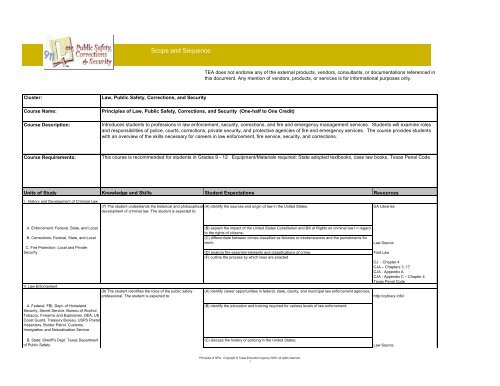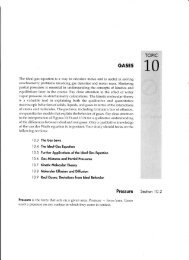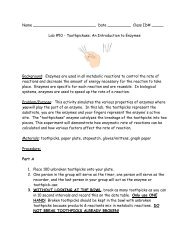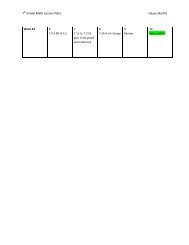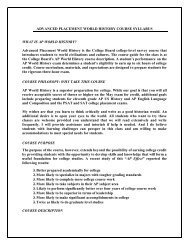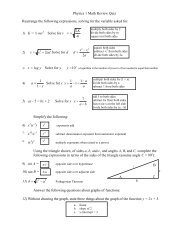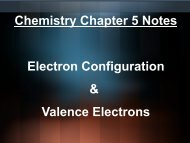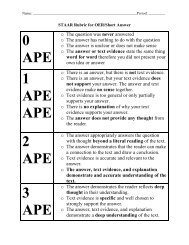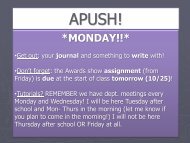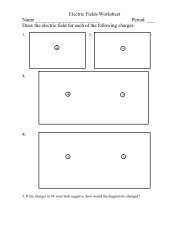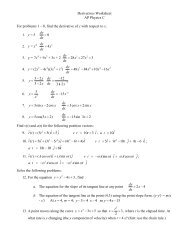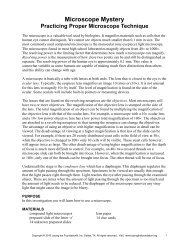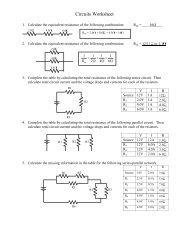Scope and Sequence
Scope and Sequence
Scope and Sequence
Create successful ePaper yourself
Turn your PDF publications into a flip-book with our unique Google optimized e-Paper software.
<strong>Scope</strong> <strong>and</strong> <strong>Sequence</strong>TEA does not endorse any of the external products, vendors, consultants, or documentations referenced inthis document. Any mention of vendors, products, or services is for informational purposes only.Cluster:Course Name:Course Description:Law, Public Safety, Corrections, <strong>and</strong> SecurityPrinciples of Law, Public Safety, Corrections, <strong>and</strong> Security (One-half to One Credit)Introduces students to professions in law enforcement, security, corrections, <strong>and</strong> fire <strong>and</strong> emergency management services. Students will examine roles<strong>and</strong> responsibilities of police, courts, corrections, private security, <strong>and</strong> protective agencies of fire <strong>and</strong> emergency services. The course provides studentswith an overview of the skills necessary for careers in law enforcement, fire service, security, <strong>and</strong> corrections.Course Requirements:This course is recommended for students in Grades 9 - 12. Equipment/Materials required: State adopted textbooks, case law books, Texas Penal CodeUnits of Study Knowledge <strong>and</strong> Skills Student Expectations ResourcesI. History <strong>and</strong> Development of Criminal Law(7) The student underst<strong>and</strong>s the historical <strong>and</strong> philosophicaldevelopment of criminal law. The student is expected to:(A) identify the sources <strong>and</strong> origin of law in the United States.UA LibrariesA. Enforcement: Federal, State, <strong>and</strong> Local (B) explain the impact of the United States Constitution <strong>and</strong> Bill of Rights on criminal law I n regardto the rights of citizens;B. Corrections: Federal, State, <strong>and</strong> Local(C) differentiate between crimes classified as felonies or misdemeanors <strong>and</strong> the punishments foreach;C. Fire Protection: Local <strong>and</strong> PrivateSecurity(D) analyze the essential elements <strong>and</strong> classifications of crime;(F) outline the process by which laws are enactedII. Law Enforcement(8) The student identifies the roles of the public safetyprofessional. The student is expected to:(A) identify career opportunities in federal, state, county, <strong>and</strong> municipal law enforcement agencies;Law SourceFind LawCJ - Chapter 4CJA – Chapters 3, 17CJA - Appendix ACJA - Appendix C – Chapter 4Texas Penal Codehttp://cybrary.info/A. Federal: FBI, Dept. of Homel<strong>and</strong>Security, Secret Service, Bureau of Alcohol,Tobacco, Firearms <strong>and</strong> Explosives, DEA, USCoast Guard, Treasury Bureau, USPS PostalInspectors, Border Patrol, Customs,Immigration <strong>and</strong> Naturalization Service(B) identify the education <strong>and</strong> training required for various levels of law enforcement;B. State: Sheriff's Dept. Texas Departmentof Public Safety(C) discuss the history of policing in the United States;Law SourcePrinciples of GPA. Copyright © Texas Education Agency 2009. All rights reserved.1
Units of Study Knowledge <strong>and</strong> Skills Student Expectations ResourcesC. Local: City Police <strong>and</strong> Constables(2) The student uses communication skills in creating,expressing, <strong>and</strong> interpreting information <strong>and</strong> ideas,including technical terminology <strong>and</strong> information. Thestudent is expected to:(D) identify the roles an responsibilities of law enforcement professionals;(E) analyze the impact of constitutional law on police as it relates to arrest, use of force, searches,<strong>and</strong> seizures;(A) model effective use of grammar to demonstrate verbal communication skills;Amnesty(B) execute speaking strategies used to communicate specific ideas to various audiences;Find Law(C) interpret voice quality <strong>and</strong> delivery to interpret verbal communication; <strong>and</strong>(D) model effective interpersonal skills necessary to communicate with coworkers <strong>and</strong> the public. CJ – Chapters 5,6,7,8(3) The student formulates ideas, proposals, <strong>and</strong> solutionsto address problems related to law, public safety,corrections, <strong>and</strong> security in order to ensure effective <strong>and</strong>efficient delivery of services. The student is expected to:(A) use logical constructions to formulate ideas, proposals, <strong>and</strong> solutions to problems;(B) formulate ideas, proposals, <strong>and</strong> solutions to ensure delivery of services; <strong>and</strong>(C) use critical-thinking skills to solve ethical issues identified in law, public safety, corrections, <strong>and</strong>security.(5) The student analyzes the legal responsibilitiesassociated with roles <strong>and</strong> functions within law, public safety,corrections, <strong>and</strong> security organizations to demonstrate acommitment to professional <strong>and</strong> ethical behavior. Thestudent is expected to:(A) examine real-world situations involving ethical dilemmas <strong>and</strong> professional conduct;(B) explain laws, regulations, <strong>and</strong> policies that govern professionals; <strong>and</strong> CJA - Chapters 4, 5, 6, 7, 8(C) recommend a strategy for responding to an unethical or illegal situation. CJA - Appendix C – Chapters 3, 4(7) The student underst<strong>and</strong>s the historical <strong>and</strong> philosophicaldevelopment of criminal law. The student is expected to:(E)identify problems commonly associated with the enforcement of criminal laws; <strong>and</strong>www.careersafeonline.comIII. Court Roles, Processes <strong>and</strong> ProceduresA. Functions of the Court: Federal, State,Municipal, Justice of the PeaceB. Roles: Judge, Justice of the Peace,Magistrate, Master-Supreme Court,Prosecutor, Defense Attorney, Defendant,Victims, Court Reporter, Witnesses(9) The student identifies the roles <strong>and</strong> functions of courtsystems. The student is expected to:(A) identify career opportunities in the court systems;(B) identify the levels <strong>and</strong> functions of criminal courts;(C) examine the roles of the courtroom work groups such as judges, prosecutors, defense counsel,<strong>and</strong> bailiffs;Texas Penal CodeLaw SourceC. Courtroom Procedures (D) explain pretrial <strong>and</strong> courtroom procedures; <strong>and</strong>D. Sentencing(E) identify types of sentencing <strong>and</strong> sentencing rules.www.loc.gov/law/index.phpFind LawCJ - 9, 10, 11CJA - Chapters 8, 9, 10, 11CJA - Chapters 8, 9, 10, 11IV. Corrections(3) The student formulates ideas, proposals, <strong>and</strong> solutionsA. Corrections: Federal, State, Local, to address problems related to law, public safety,Private Prisonscorrections, <strong>and</strong> security in order to ensure effective <strong>and</strong>B. Functions: Warden, Officers, Offenders, efficient delivery of services. The student is expected to:Project RIO Assessment Specialist, Principal,Teachers, Adult vs. Juvenile(5) The student analyzes the legal responsibilitiesassociated with roles <strong>and</strong> functions within law, public safety,corrections, <strong>and</strong> security organizations to demonstrate acommitment to professional <strong>and</strong> ethical behavior. Thestudent is expected to:(A) use logical constructions to formulate ideas, proposals, <strong>and</strong> solutions to problems;(B) formulate ideas, proposals, <strong>and</strong> solutions to ensure delivery of services; <strong>and</strong>(C) use critical-thinking skills to solve ethical issues identified in law, public safety, corrections, <strong>and</strong>security.(A) examine real-world situations involving ethical dilemmas <strong>and</strong> professional conduct;(B) explain laws, regulations, <strong>and</strong> policies that govern professionals; <strong>and</strong>(C) recommend a strategy for responding to an unethical or illegal situation.cybrary.infoLaw SourceAmnestyPrinciples of GPA. Copyright © Texas Education Agency 2009. All rights reserved.2
Units of Study Knowledge <strong>and</strong> Skills Student Expectations Resources(10) The student identifies the roles <strong>and</strong> functions of thecorrectional system. The student is expected to:(A) explain career opportunities available in the correctional system, including probation <strong>and</strong> CJ - Chapter 12parole;(B) explain the duties <strong>and</strong> responsibilities of correctional officers; CJA - Chapters 12, 13, 14(C) outline the history of prisons in the United States;(D) explain the differences between jails <strong>and</strong> prisons; CJA - Appendix C – Chapter 12(E) identify the levels of security in prisons <strong>and</strong> jails; <strong>and</strong>(F) explain the constitutional rights of inmates in prisons <strong>and</strong> jails.V. Private Security(3) The student formulates ideas, proposals, <strong>and</strong> solutions (A) use logical constructions to formulate ideas, proposals, <strong>and</strong> solutions to problems;Find LawA. Corporations to address problems related to law, public safety,(B) formulate ideas, proposals, <strong>and</strong> solutions to ensure delivery of services; <strong>and</strong>B. Partnerships corrections, <strong>and</strong> security in order to ensure effective <strong>and</strong>efficient delivery of services. The student is expected to:(C) use critical-thinking skills to solve ethical issues identified in law, public safety, corrections, <strong>and</strong>security.C. Sole-Proprietorship(11) The student identifies the roles <strong>and</strong> functions of private (A) explain the career opportunities available in private security;D. Changing role on Private Security security systems <strong>and</strong> agencies. The student is expected to:E. Private Investigator License (B) discuss the history <strong>and</strong> importance of private security in the United States; <strong>and</strong>F. Security Guard License(C) examine the relationship between private security <strong>and</strong> public safety agencies.VI. Fire Protection Services(3) The student formulates ideas, proposals, <strong>and</strong> solutions (A) use logical constructions to formulate ideas, proposals, <strong>and</strong> solutions to problems;Find LawA. Functions to address problems related to law, public safety,(B) formulate ideas, proposals, <strong>and</strong> solutions to ensure delivery of services; <strong>and</strong>B. Types of Fires corrections, <strong>and</strong> security in order to ensure effective <strong>and</strong>efficient delivery of services. The student is expected to:(C) use critical-thinking skills to solve ethical issues identified in law, public safety, corrections, <strong>and</strong>security.C. Fire PreventionD. Fire Safety(8) The student identifies the roles of the public safetyprofessional. The student is expected to:(F) examine the role of emergency medical services in public safety; <strong>and</strong>CJA - Appendix C(12) The student identifies the roles <strong>and</strong> functions of fire (A) identify the career opportunities in fire protection services;CJA - Chapters 3, 16, 19, 22, 28protection services. The student is expected to:(B) explain the duties <strong>and</strong> responsibilities of firefighters;(C) recognize the importance of the operation of 911 <strong>and</strong> computer-aided dispatch systems; <strong>and</strong>(D) explain the relationship between police, fire, <strong>and</strong> emergency medical services.VII. Interagency Collaboration(6) The student recognizes the importance of interagency (A) discuss the importance of police, fire, emergency medical services, court, corrections, <strong>and</strong> Find LawA. Federal cooperation. The student is expected to:security systems working together to protect the public;www.fema.govB. State (B) explain the roles <strong>and</strong> responsibilities of first responders;C. Local (C) identify jurisdictional problems that may arise as multiple agencies work together; <strong>and</strong>D. BenefitsE. Challenges(D) differentiate between the roles of private security <strong>and</strong> public law enforcement agencies.VIII. Personal <strong>and</strong> Work Related Health, Safety <strong>and</strong> Ethics(4) The student implements measures to maintain safe <strong>and</strong> (A) identify the dangers associated with careers in law, public safety, corrections, <strong>and</strong> security; Find LawA. OSHA: Hazardous MaterialsB. Healthhealthful working conditions in a law <strong>and</strong> public safetyenvironment. The student is expected to:(B) recommend strategies for issues related to the safety <strong>and</strong> health of employees based on anassessment of a simulated workplace environment;C. Self-Defense (C) discuss methods for safe h<strong>and</strong>ling of hazardous materials; CJA - Chapter 7D. Weapons: Biochemical, Intermediate,OC Pepper Spray, Tasers(D) discuss the importance of good health <strong>and</strong> physical fitness; <strong>and</strong>(E) demonstrate first aid <strong>and</strong> cardiopulmonary resuscitation procedures.CJA - Appendix CCJA - Chapters 16, 19, 22. 28(8) The student identifies the roles of the public safety (G) identify how public safety professionals manage the stress related to these jobs.professional. The student is expected to:IX. High School <strong>and</strong> Beyond(1) The student achieves academic knowledge <strong>and</strong> skillsrequired for a career <strong>and</strong> postsecondary education(A) apply English language arts knowledge <strong>and</strong> skills required for career <strong>and</strong> postsecondaryeducation opportunities;Find LawA. Interest Inventory opportunities associated with law, public safety, corrections, (B) apply mathematics knowledge <strong>and</strong> skills required for career <strong>and</strong> postsecondary education CJA - Appendix B<strong>and</strong> security. The student is expected to:opportunities; <strong>and</strong>B. Job Market (C) apply science knowledge <strong>and</strong> skills for career <strong>and</strong> postsecondary education associated with www.fbi.govC. Career <strong>and</strong> Technical Education law, public safety, corrections, <strong>and</strong> security.www.usajobs.govD. College www.officer.comPrinciples of GPA. Copyright © Texas Education Agency 2009. All rights reserved.3
Units of Study Knowledge <strong>and</strong> Skills Student Expectations ResourcesE. On the Job Training www.abanet.comF. Salaries: Full-Time vs. Part-Timewww.fjc.govEmployment, Employee Benefitswww.judges.orgwww.isac.comwww.corrections.comwww.appa-net.orgResources: BooksCJ Pearson/Prentice Hall, Criminal Justice, 2003, James Fagin205366937CJAResources: Web SitesUA LibrariesLaw SourceFind LawAmnestyThomson/Wadsworth, Criminal Justice in Action Texas Protective Services Edition (second edition), 2003, Larry Gaines, Roger MillerTexas Penal Codehttp://library.albany.edu/subject/criminal.htmhttp://www.lawsource.com/also/http://www.findlaw.com/http://www.amnesty.org/www.careersafeonline.comhttp://tlo2.tlc.state.tx.us/statutes/pe.toc.htmwww.loc.gov/law/index.phpwww.fema.govwww.fbi.govwww.usajobs.govwww.usdoj.govwww.officer.comwww.abanet.comwww.fjc.govwww.judges.orgwww.corrections.comwww.appa-net.org053464869XAdditional Resources:049500605X Criminal Evidence : Principles <strong>and</strong> Cases534172911 6 Steps to Effective Writing in Criminal Justice131195131 Careers in Criminal Justice-CD (Software)495600326 Careers in Criminal Justice: From Internship to Promotion314146504 Concise Hornbook Series, Principles of Criminal Law027102920X Cops Across Borders : The Internationalization of U. S. Criminal Law Enforcement763735000 Corrections <strong>and</strong> the Criminal Justice SystemPrinciples of GPA. Copyright © Texas Education Agency 2009. All rights reserved.4


